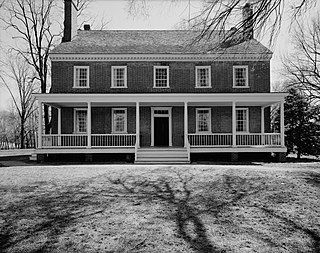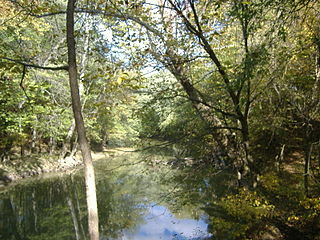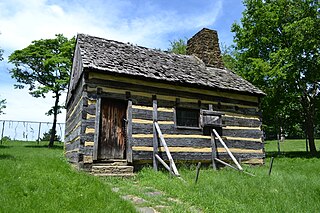
Scouting in Indiana has a long history, from the 1910s to the present day, serving thousands of youth in programs that suit the environment in which they live.

Clarksville is a town in Clark County, Indiana, United States, along the Ohio River and is a part of the Louisville Metropolitan area. The population was 21,724 at the 2010 census. The town was founded in 1783 by early resident George Rogers Clark at the only seasonal rapids on the entire Ohio River, it is the oldest American town in the former Northwest Territory. The town is home to the Colgate clock, one of the largest clocks in the world and the Falls of the Ohio State Park, home to the world's largest exposed Devonian period fossil bed.

Vincennes is a city in and the county seat of Knox County, Indiana, United States. It is located on the lower Wabash River in the southwestern part of the state, nearly halfway between Evansville and Terre Haute. Founded in 1732 by French fur traders, notably François-Marie Bissot, Sieur de Vincennes, for whom the Fort was named, Vincennes is the oldest continually inhabited European settlement in Indiana and one of the oldest settlements west of the Appalachians.

Turkey Run State Park, Indiana's second state park, is in Parke County in the west-central part of the state along State Road 47, 2 miles (3.2 km) east of U.S. 41.

George Rogers Clark was an American surveyor, soldier, and militia officer from Virginia who became the highest-ranking American patriot military officer on the northwestern frontier during the American Revolutionary War. He served as leader of the militia in Kentucky throughout much of the war. He is best known for his captures of Kaskaskia (1778) and Vincennes (1779) during the Illinois Campaign, which greatly weakened British influence in the Northwest Territory. The British ceded the entire Northwest Territory to the United States in the 1783 Treaty of Paris, and Clark has often been hailed as the "Conqueror of the Old Northwest".

Historic Locust Grove is a 55-acre 18th-century farm site and National Historic Landmark situated in eastern Jefferson County, Kentucky. The site is owned by the Louisville Metro government, and operated as a historic interpretive site by Historic Locust Grove, Inc.

The geology of the Ohio River, with but a single series of rapids halfway in its length from the confluence of the Monongahela and Allegheny rivers to its union with the Mississippi, made it inevitable that a town would grow on the site. Louisville, Kentucky was chartered in the late 18th century. From its early days on the frontier, it quickly grew to be a major trading and distribution center in the mid 19th century, important industrial city in the early 20th, declined in the mid 20th century, before revitalizing in the late 20th century as a culturally-focused mid-sized American city.

George Rogers Clark National Historical Park, located in Vincennes, Indiana, on the banks of the Wabash River at what is believed to be the site of Fort Sackville, is a United States National Historical Park. President Calvin Coolidge authorized a classical memorial and President Franklin D. Roosevelt dedicated the completed structure in 1936.

The National Register of Historic Places in the United States is a register including buildings, sites, structures, districts, and objects. The Register automatically includes all National Historic Landmarks as well as all historic areas administered by the U.S. National Park Service. Since its introduction in 1966, more than 90,000 separate listings have been added to the register.

Falls of the Ohio State Park is a state park in the U.S. state of Indiana. It is located on the banks of the Ohio River at Clarksville, Indiana, across from Louisville, Kentucky. The park is part of the Falls of the Ohio National Wildlife Conservation Area. The exposed fossil beds of the Jeffersonville Limestone dated from the Devonian period are the main feature of the park, attracting about 160,000 visitors annually. The Falls was the site where Lewis & Clark met for the Lewis and Clark Expedition at George Rogers Clark's cabin.

Fort Massac was a French colonial and early National-era fort on the Ohio River in Massac County, Illinois, United States.

John Work House and Mill Site is a site listed on the National Register of Historic Places in Indiana just outside Charlestown, owned by the Lincoln Heritage Council, (BSA), as part of the Tunnel Mill Scout Reservation. For a century, it was an active gristmill until technology made it obsolete, and arson destroyed much of it. Prominent features around the site are Fourteen Mile Creek and the Devil's Backbone. The land is now used by the Boy Scouts of America for camping activities such as National Youth Leadership Training and a Webelos Camp. In 2010, part of the Tunnel Mill camp was leased to a private company for the purpose of restoring the Historic John Work House for use as a living history center. In order to prevent vandalism and amateur ghost hunters from further damaging the building, security guards patrol the property each night.

The Old Jeffersonville Historic District is located in Jeffersonville, Indiana, United States. It marks the original boundaries of Jeffersonville, and is the heart of modern-day downtown Jeffersonville. It was placed on the National Register of Historic Places in 1983. The area is roughly bounded by Court Avenue at the North, Graham Street on the east, the Ohio River at the south, and Interstate 65 at the west. In total, the district has 203 acres (0.8 km2), 500 buildings, 6 structures, and 11 objects. Several banks are located in the historic buildings in the district. The now defunct Steamboat Days Festival, held on the second weekend in September, used to be held on Spring Street and the waterfront. Jeffersonville's largest fire wiped out a block in the historic district on January 11, 2004 which destroyed the original Horner's Novelty store.

Silver Creek is a stream in southern Indiana in the United States. It drains a watershed of 97,442 acres (394.33 km2). The creek rises in Scott County and flows 38.0 miles (61.2 km), dropping 168 feet (51 m), before flowing into the Ohio River.

John Henry Minta was a politician of Clarksville, Indiana, where he was involved with the town's government for 32 years and nicknamed Mr. Clarksville. During his time with the town's government he served on the Parks Board, Town Council, and was the Council President.

The Vincennes Trace was a major trackway running through what are now the American states of Kentucky, Indiana, and Illinois. Originally formed by millions of migrating bison, the Trace crossed the Ohio River near the Falls of the Ohio and continued northwest to the Wabash River, near present-day Vincennes, before it crossed to what became known as Illinois. This buffalo migration route, often 12 to 20 feet wide in places, was well known and used by American Indians. Later European traders and American settlers learned of it, and many used it as an early land route to travel west into Indiana and Illinois. It is considered the most important of the traces to the Illinois country.

George Washington's Gristmill was part of the original Mount Vernon plantation, constructed during the lifetime of the United States' first president. The original structure was destroyed about 1850. The Commonwealth of Virginia and the Mount Vernon Ladies’ Association have reconstructed the gristmill and the adjacent distillery. The reconstructed buildings are located at their original site three miles (5 km) west of Mount Vernon proper near Woodlawn Plantation in Alexandria, Virginia. Because the reconstructed buildings embody the distinctive characteristics of late eighteenth century methods of production and are of importance to the history of Virginia, the site is listed on the National Register of Historic Places despite the fact that the buildings are not original.

The Neal Log House is a historic log cabin built in 1765 in Pittsburgh, Pennsylvania. The Neal Log House is the oldest existing residential structure in Pittsburgh and one of the last few buildings left from the eighteenth century. The two other buildings - the Old Stone Inn, 1756 and The Fort Pitt Block House, 1764 are not residential structures. The Pittsburgh History and Landmarks Foundation placed a Historic Landmark Plaque on the building in 1970. In 1977, it was named a City of Pittsburgh Designated Historic Structure. It is part of Schenley Park U.S. Historic District The house was originally called the "Neal Log House" which is the predominant spelling of the family’s name. However in various documents the last name was spelled Neil and on one document Neill. In 1969 Charles Covert Arensberg wrote a paper entitled "The spelling of Robert Neill who built the Neill Log House in Schenley Park". It is now known that Arensberg made several erroneous assumptions about the spelling of the last name. Unfortunately the 1969 paper was used to submit to the city to change the name from "Neal" to "Neill" in spite of the fact the most common spelling of the family’s name was "Neal". [6].



















